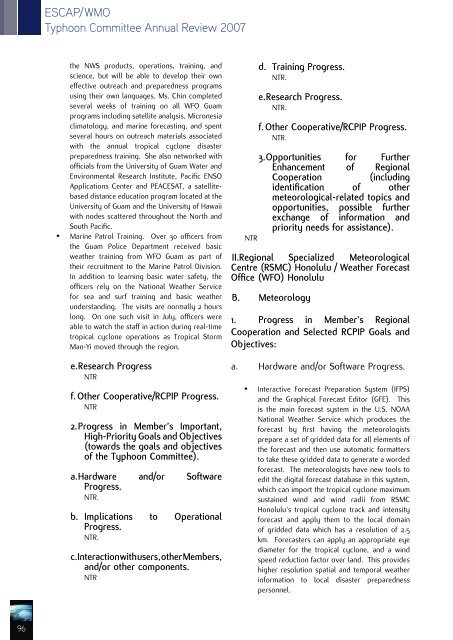200 - Typhoon Committee
200 - Typhoon Committee
200 - Typhoon Committee
Create successful ePaper yourself
Turn your PDF publications into a flip-book with our unique Google optimized e-Paper software.
ESCAP/WMO<br />
<strong>Typhoon</strong> <strong>Committee</strong> Annual Review <strong>200</strong>7<br />
the NWS products, operations, training, and<br />
science, but will be able to develop their own<br />
effective outreach and preparedness programs<br />
using their own languages. Ms. Chin completed<br />
several weeks of training on all WFO Guam<br />
programs including satellite analysis, Micronesia<br />
climatology, and marine forecasting, and spent<br />
several hours on outreach materials associated<br />
with the annual tropical cyclone disaster<br />
preparedness training. She also networked with<br />
officials from the University of Guam Water and<br />
Environmental Research Institute, Pacific ENSO<br />
Applications Center and PEACESAT, a satellitebased<br />
distance education program located at the<br />
University of Guam and the University of Hawaii<br />
with nodes scattered throughout the North and<br />
South Pacific.<br />
• Marine Patrol Training. Over 30 officers from<br />
the Guam Police Department received basic<br />
weather training from WFO Guam as part of<br />
their recruitment to the Marine Patrol Division.<br />
In addition to learning basic water safety, the<br />
officers rely on the National Weather Service<br />
for sea and surf training and basic weather<br />
understanding. The visits are normally 2 hours<br />
long. On one such visit in July, officers were<br />
able to watch the staff in action during real-time<br />
tropical cyclone operations as Tropical Storm<br />
Man-Yi moved through the region.<br />
NTR<br />
d. Training Progress.<br />
NTR.<br />
e. Research Progress.<br />
NTR.<br />
f. Other Cooperative/RCPIP Progress.<br />
NTR.<br />
3. Opportunities for Further<br />
Enhancement of Regional<br />
Cooperation (including<br />
identification of other<br />
meteorological-related topics and<br />
opportunities, possible further<br />
exchange of information and<br />
priority needs for assistance).<br />
II.Regional Specialized Meteorological<br />
Centre (RSMC) Honolulu / Weather Forecast<br />
Office (WFO) Honolulu<br />
B. Meteorology<br />
1. Progress in Member’s Regional<br />
Cooperation and Selected RCPIP Goals and<br />
Objectives:<br />
e. Research Progress<br />
NTR<br />
f. Other Cooperative/RCPIP Progress.<br />
NTR<br />
2. Progress in Member’s Important,<br />
High-Priority Goals and Objectives<br />
(towards the goals and objectives<br />
of the <strong>Typhoon</strong> <strong>Committee</strong>).<br />
a. Hardware<br />
Progress.<br />
and/or Software<br />
NTR.<br />
b. Implications<br />
Progress.<br />
to Operational<br />
NTR.<br />
c. Interaction with users, other Members,<br />
and/or other components.<br />
NTR<br />
a. Hardware and/or Software Progress.<br />
• Interactive Forecast Preparation System (IFPS)<br />
and the Graphical Forecast Editor (GFE). This<br />
is the main forecast system in the U.S. NOAA<br />
National Weather Service which produces the<br />
forecast by first having the meteorologists<br />
prepare a set of gridded data for all elements of<br />
the forecast and then use automatic formatters<br />
to take these gridded data to generate a worded<br />
forecast. The meteorologists have new tools to<br />
edit the digital forecast database in this system,<br />
which can import the tropical cyclone maximum<br />
sustained wind and wind radii from RSMC<br />
Honolulu’s tropical cyclone track and intensity<br />
forecast and apply them to the local domain<br />
of gridded data which has a resolution of 2.5<br />
km. Forecasters can apply an appropriate eye<br />
diameter for the tropical cyclone, and a wind<br />
speed reduction factor over land. This provides<br />
higher resolution spatial and temporal weather<br />
information to local disaster preparedness<br />
personnel.<br />
96
















